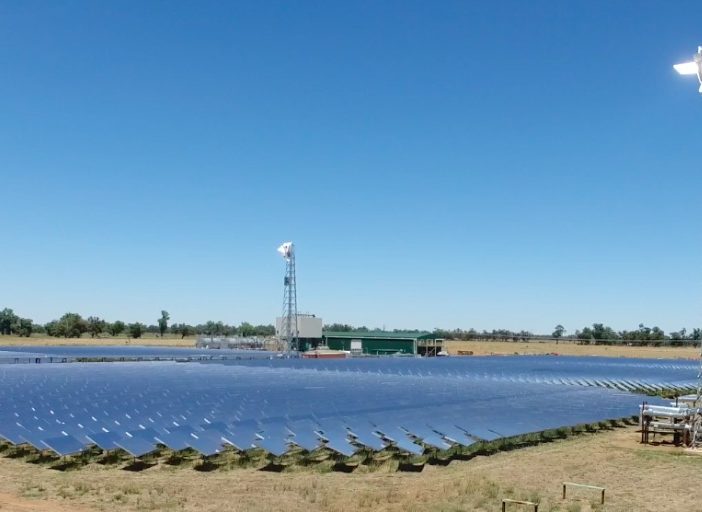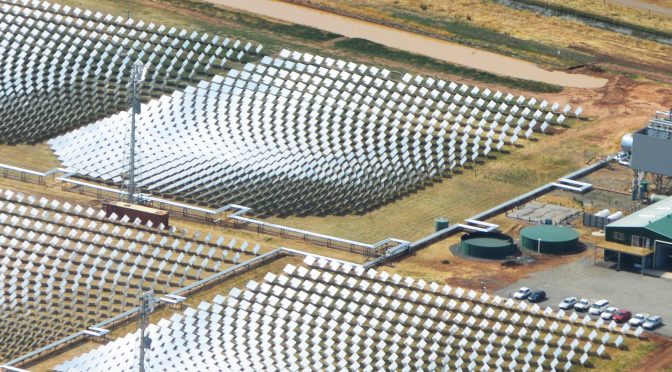A novel plan for a 50 megawatt hybrid Concentrated Solar Power project in Mount Isa has got financial backing from Queensland government-owned energy giant Stanwell Energy.
The $600 million project, proposed last year by thermal solar specialist Vast Solar, would mix a unique brand of concentrated thermal solar generation with solar PV, gas peaking and a battery to provide power to Mount Isa and the wider North West Minerals Province, which is cut off from the National Energy Market.

Under the joint development agreement announced today, Stanwell will initially provide $5 million towards a feasibility study, with Vast Solar also providing $5 million. The study will examine logistical details, planning requirements, customer off-take, and financing.
Vast Solar chief executive Craig Wood said the study would be finished by the end of the year, and the project would then be ready to take to shareholders for approval.
All going well, he said construction should begin in the second quarter of 2022. He said the plan was for Stanwell to continue as a partner into the construction phase, though that was yet to be negotiated formally.
“It’s a big deal for Vast Solar to be partnered with the largest generator in Queensland. They have a lot of experience in operating assets commercially in the Mount Isa region. It’s a terrific thing to be allied with them,” he said.
The $600 million project, proposed last year by thermal solar specialist Vast Solar, would mix a unique brand of concentrated thermal solar generation with solar PV, gas peaking and a battery to provide power to Mount Isa and the wider North West Minerals Province, which is cut off from the National Energy Market.
Under the joint development agreement announced today, Stanwell will initially provide $5 million towards a feasibility study, with Vast Solar also providing $5 million. The study will examine logistical details, planning requirements, customer off-take, and financing.
Vast Solar chief executive Craig Wood said the study would be finished by the end of the year, and the project would then be ready to take to shareholders for approval.
All going well, he said construction should begin in the second quarter of 2022. He said the plan was for Stanwell to continue as a partner into the construction phase, though that was yet to be negotiated formally.
“It’s a big deal for Vast Solar to be partnered with the largest generator in Queensland. They have a lot of experience in operating assets commercially in the Mount Isa region. It’s a terrific thing to be allied with them,” he said.
Wood says the thermal solar technology his company has designed is unique, combining elements from the two major forms of concentrated solar power (CSP): solar towers, and parabolic troughs.
Both technologies use mirrors to concentrate the sun’s rays and heat up a liquid – either oil or molten sodium – which is then used to heat water, creating steam which powers a turbine. Unlike solar PV, CSP can store energy in the molten salt, and provide power when the sun is not shining.
Vast Solar’s technology differs from the tower method in that instead of using one big tower, it uses lots of small towers (around 30 in this case) which brings it closer in some ways to the parabolic trough process. But unlike parabolic trough technology – which first heats up oil, and then transfers that heat to molten sodium – it directly heats the molten sodium. Wood says this makes it much more efficient and allows the molten sodium to reach a higher temperature, as the oil is limited to 400 degrees, but molten salt can reach 600 degrees.
The problem with this method, though, is the molten sodium has tended to damage equipment because it fluctuates in temperature. But Wood says his company has developed a patented technology that solves this problem through the use of a valve that controls flow.
For Mount Isa, the idea is that solar PV will provide power in the day, solar thermal in the night, and any gaps will be filled by backup from a relatively small battery and a gas peaking plant. He said the result would be an 85 per cent reduction in carbon emissions from Mount Isa’s current power supply, which is 100 per cent gas. He said the system would be 99.5 per cent reliable, meaning the hybrid system could be said to provide “baseload” power.
“The ability to provide 85 per cent deacarbonised baseload reliable energy is something that is going to be extremely attractive to other mining companies who otherwise have to pipe in or truck in fossil fuelm” he said.
The project will require an upfront investment of $600 million, and Wood says he hopes to secure some funding from Australian Renewable Energy Corporation, the Clean Energy Finance Corporation and the Northern Australia Infrastructure Facility. Stanwell’s involvement, should it continue beyond the feasibility study, would likely boost its chances of raising the necessary capital.
Until the end of last year, Stanwell operated the 218 MW Mica Creek Power Station near Mount Isa, but shut it down on January 1 saying it required an expensive overhaul and could no longer compete with more modern power generators.
That means the regional grid, known as the North West Power System, which is not connected to the National Energy Market, is powered by APA’s Diamantina and Leichhardt gas-fired power stations providing around 300 MW of capacity. APA is which also planning a third 18MW plant APA for the region.
Further capacity could come from the Copperstring 2.0 transmission line, a plan to connect Mount Isa to the national grid with a 1,100 kilometre high voltage line. The $1.5 billion project is yet to begin construction, though earlier this month CIMIC Group’s UGL and CPB Contractors announced they had signed early-stage contracts to construct it.
Wood said neither APA’s existing and planned capacity nor the Copperstring 2.0 project affected the feasibility of Vast Solar’s plan.
“There is, we believe, an opportunity over the sorts of timeframe we’re looking at for the market to accept another 50MW of generation. And the pricing we’re able to deliver by using 85 per cent renewable power is significantly cheaper than the gas fired generation that’s currently there.”
Wood has big plans beyond Mount Isa, and believes the project will be a living laboratory for what his brand of solar thermal can do. He said he envisages projects of 100MW or more in the future, saying one major advantage of his small tower technology is that it can be scaled as needed up in a piecemeal fashion relatively easily.
“The reality is at 100MW the economics actually become signficantly more compelling again. So we actually see quite an opportunity for deployment of more of this sort of thing in the North West Power System. You can do that in stages as existing contracts people have for power supply mature. Another pace where similar systems make a lot of sense is places with large mining loads that need to decarbonis, like the Pilbara in WA and Olympic Dam in South Australia. These are all terrific loads for CSP plus PV hybrids,” he said.
Stanwell chief executive Richard Van Breda said Stanwell was “excited to see another renewable energy project take a real step towards realisation”.
“Projects such as these are integral to the development and diversification of our energy portfolio around the state. Our involvement in the feasibility study reflects our ongoing commitment to the people of Mount Isa and Queensland, and to the environment,” he said.
“This project illustrates our values by delivering a better Queensland through transitioning to a lower carbon future while still contributing to the economy, creating jobs and delivering low-cost energy to homes and businesses.”James Fernyhough
James Fernyhough is a reporter at RenewEconomy. He has worked at The Australian Financial Review and the Financial Times, and is interested in all things related to climate change and the transition to a low-carbon economy.


